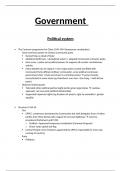Summary
Summary Mao's China - Government
- Course
- Institution
Written by a Cambridge Law student with an A* at history A-level. Outlines the different aspects and periods of government including the Common Programme, 1954 Constitution, reunification campaigns, Korean war, PLA and social control, laogai network, Great Terror, Denunciation Campaigns and Hun...
[Show more]



